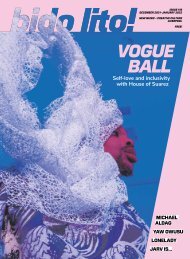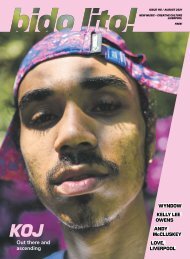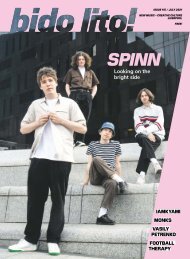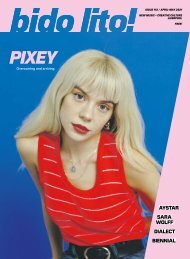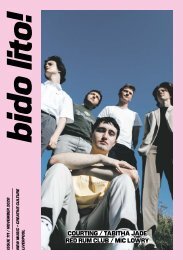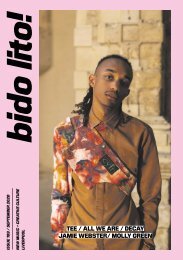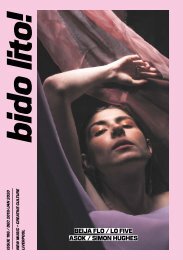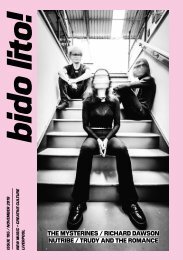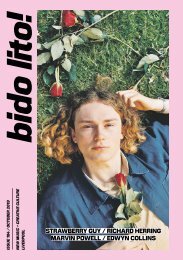Issue 61 / November 2015 - SIDE AA
Our special double A-side issue featuring Giorgio Moroder on one cover, and The Stairs on the other.
Our special double A-side issue featuring Giorgio Moroder on one cover, and The Stairs on the other.
You also want an ePaper? Increase the reach of your titles
YUMPU automatically turns print PDFs into web optimized ePapers that Google loves.
FREE<br />
<strong>Issue</strong> <strong>61</strong><br />
<strong>November</strong> <strong>2015</strong><br />
Giorgio Moroder by Mike Isted<br />
Giorgio Moroder<br />
The Stairs<br />
Bill Ryder-Jones<br />
TVAM<br />
Music For<br />
Empty Spaces
facebook.com/o2academyliverpool<br />
twitter.com/o2academylpool<br />
instagram.com/o2academyliverpool<br />
youtube.com/o2academytv<br />
Thurs 29th Oct • £11 adv<br />
Prides<br />
Sat 31st Oct • £16 adv<br />
Hawklords<br />
Sun 1st Nov • £25 adv<br />
Fish<br />
Farewell to Childhood<br />
Fri 6th Nov • £12 adv<br />
The Sunshine<br />
Underground<br />
Sat 7th Nov • £15 adv<br />
Lucy Rose<br />
Sat 7th Nov • £15 adv<br />
The Carpet Crawlers<br />
The Ultimate Genesis Tribute performing<br />
The Lamb Lies Down On Broadway<br />
Tues 10th Nov • £17.50 adv<br />
The Fratellis<br />
Thurs 12th Nov • £19 adv<br />
Joey Bada$$<br />
Thurs 12th Nov • £16 adv<br />
Paradise Lost<br />
Fri 13th Nov •<br />
Happy Mondays<br />
Pills ‘n’ Thrills and Bellyaches<br />
25th Anniversary Tour<br />
Fri 13th Nov • £5 adv<br />
Happy Mondays<br />
aftershow party<br />
ft. Steve Proctor (DJ set)<br />
Sat 14th Nov • £20 adv<br />
Newton Faulkner<br />
Thurs 19th Nov • £20 adv<br />
Public Service<br />
Broadcasting<br />
Fri 20th Nov •<br />
James Morrison<br />
Fri 20th Nov • £14 adv<br />
Absolute Bowie<br />
Sat 21st Nov • £14 adv<br />
Reverend & The Makers<br />
Sun 22nd Nov • £15 adv<br />
Deaf Havana<br />
Mon 23rd Nov • £13.50 adv<br />
Chad Valley<br />
Tues 24th Nov •<br />
Slaves<br />
Wed 25th Nov • £19.50 adv<br />
The Wailers<br />
Performing the album Legend in its entirety<br />
Thurs 26th Nov • £10 adv<br />
Kvelertak<br />
Fri 27th Nov • £12 adv<br />
The Doors Alive<br />
Sat 28th Nov • £10 adv<br />
The Hummingbirds<br />
Sat 28th Nov • £8 adv<br />
The Sherlocks<br />
Mon 30th Nov • £10 adv<br />
Jaws<br />
+ Nai Harvest<br />
Tues 1st Dec • £15 adv<br />
Courtney Barnett<br />
Tues 1st Dec • £13.50 adv<br />
The Rifles (Acoustic)<br />
Wed 2nd Dec • £30 adv<br />
Public Enemy<br />
Wed 2nd Dec • £10 adv<br />
Dorje<br />
Thurs 3rd Dec • £22.50 adv<br />
Scouting For Girls<br />
+ Mike Dignam<br />
Thurs 3rd Dec • £12.50 adv<br />
Electric Six<br />
Fri 4th Dec • £13 adv<br />
The Lancashire Hotpots<br />
Sat 5th Dec • £20 adv<br />
The Rutles<br />
Fri 11th Dec • £25 adv<br />
Echo & The Bunnymen<br />
Sat 12th Dec •<br />
Echo & The Bunnymen<br />
Fri 18th Dec •<br />
The Charlatans<br />
Sat 19th Dec • £16 adv<br />
The Beat<br />
Sat 19th Dec • £18.50 adv<br />
The Damned<br />
Tues 22nd Dec • £6 adv<br />
Baked A La Ska<br />
Tues 26th Jan 2016 • £22.50 adv<br />
Michael Schenker’s<br />
Temple of Rock<br />
Wed 27th Jan 2016 • £11 adv<br />
Cancer Bats<br />
Fri 29th Jan 2016 • £16.50 adv<br />
Gabrielle Aplin<br />
Thurs 4th Feb 2016 • £20 adv<br />
Bowling For Soup<br />
Sun 14th Feb 2016 • £12 adv<br />
Little Comets<br />
Wed 2nd Mar 2016 • £15 adv<br />
Exodus<br />
Tues 8th Mar 2016 • £24 adv<br />
The Stranglers<br />
Wed 9th Mar 2016 • £22 adv<br />
Scott Bradlee’s<br />
Postmodern Jukebox<br />
Mon 21st Mar 2016 • £15 adv<br />
Half Moon Run<br />
Mon 9th Nov •<br />
The 1975<br />
Thurs 26th Nov •<br />
Stereophonics<br />
Sat 27th Feb 2016 • £29.50 adv<br />
Rudimental<br />
Sat 11th Jun 2016 • £28.50 adv<br />
Dr John Cooper<br />
Clarke<br />
Ticketweb.co.uk • 0844 477 2000<br />
liverpoolguild.org<br />
Thurs 12th Nov • £19 adv<br />
Joey Bada$$<br />
Wed 25th Nov • £19.50 adv<br />
The Wailers<br />
Wed 2nd Dec • £30 adv<br />
Public Enemy<br />
o2academyliverpool.co.uk<br />
11-13 Hotham Street, Liverpool L3 5UF • Doors 7pm unless stated<br />
Venue box office opening hours: Mon - Sat 11.30am - 5.30pm • No booking fee on cash transactions<br />
ticketweb.co.uk • seetickets.com • gigantic.com • ticketmaster.co.uk
Bido Lito! <strong>November</strong> <strong>2015</strong><br />
44<br />
TOGETHER IN ELECTRIC DREAMS<br />
Editorial<br />
Every now and then you find yourself at the centre of some<br />
cosmic alignment when all of your plans just magically come<br />
together, and it can feel quite surreal. This past month has been<br />
a bit like that, and I’ve had to keep pinching myself in order to<br />
remember that it’s all real (or maybe I’ve just been reading too<br />
much of Rob Chapman’s book Psychedelia And Other Colours,<br />
and projecting the idea of mescaline trips on to all the mundane<br />
aspects of putting together a magazine). This issue is definitely<br />
our most ambitious one yet, and I think we even surprised<br />
ourselves at what we could achieve.<br />
For a start, you’ve probably noticed that this month’s issue<br />
looks a little different than usual: Bido Lito! <strong>61</strong> is in two halves,<br />
introduced by two lead features that each have their own<br />
fantastic cover artwork. Now, it’s up to you which way round<br />
you navigate the magazine, and we hope you enjoy what we’ve<br />
done with it: you could say that it’s a magazine with no ending!<br />
I’d like to say thanks to the artists who worked on both of these<br />
covers, and also to our designer Mark for making the daft idea<br />
work – don’t worry mate, it’s just a one-off! Well…<br />
It’s brilliant for us to be in a position to attempt this, and<br />
that’s largely due to the support we get from you, our readers,<br />
who seem genuinely interested in what we do. We endeavour to<br />
be as creative as possible with what we do with the magazine,<br />
just like any self-respecting publication with five years under<br />
its belt should. And if we, a modestly-sized regional print<br />
magazine, can push the boundaries, then surely others with<br />
greater means can too. This is part of the reason why I was so<br />
annoyed when I picked up the first few editions of the new,<br />
free NME magazine, and noticed a distinct and insulting lack<br />
of actual journalism in there (please, no more lists, tittle-tattle<br />
news items or Chris Moyles). Even amid the great fanfare and<br />
window-dressing of the grand relaunch, you can still clearly see<br />
where the publication’s loyalties lie, with far more actual content<br />
added to NME.com’s mammoth digital output each day than is<br />
created for their flagship print product. The reason I’m so arsed<br />
about this is because I believe that NME is still a great title, with<br />
the weight of not just its own history but its vast capabilities<br />
keeping it at the top of the tree; I just wish the current holders<br />
of the magazine’s reins would respect its vast and influential<br />
platform and do something that Charles Shaar Murray, Nick Kent<br />
and Tim Jonze would be proud of. And to the naysayers who<br />
think the NME farce points to the continuing downward spiral<br />
of print publishing, I say this: print won’t die so long as there are<br />
people with ideas and passion pouring their heart into creating<br />
something that other people want to read and want to be a part<br />
of. To nick a Del Boy phrase: he who dares, wins.<br />
Going back to one of this month’s cover features, we are<br />
absolutely delighted to be teaming up with Chibuku this month<br />
to present a show at Arts Club with the father of modern disco<br />
music, Giorgio Moroder. Born in the South Tyrol region of<br />
Northern Italy – close to the Austrian border – Giovanni Giorgio<br />
(or Hans-Jörg as he was called by his mother in his youth) is one<br />
of the most influential people in 20th-century music. Not only<br />
is the visionary producer/songwriter responsible for a swathe<br />
of dancefloor greats (Donna Summer’s Hot Stuff, I Feel Love and<br />
Love To Love You, Baby, Blondie’s Call Me) but he’s also had<br />
his hand in film soundtrack classics What A Feeling (by Irene<br />
Cara for Flashdance) and Take My Breath Away (by Berlin for<br />
Top Gun, the song Moroder said he’s most proud of) – and this<br />
is just the tip of the iceberg. As Austin Wilde points out in his<br />
fascinating interview with the 75-year-old synth maestro this<br />
month, Moroder has been a huge influence on Daft Punk and<br />
pretty much everyone who’s used a synthesiser post-1977 (the<br />
D-Day moment when I Feel Love was released). This is just part<br />
of the reason why Chibuku’s An Evening With Giorgio Moroder<br />
on 14th <strong>November</strong> is such an unmissable event, up there with<br />
the night they hosted John Peel in one of their landmark events.<br />
What. A. Feeling.<br />
I have to admit that I got a bit carried away getting into the<br />
Moroder mood this month, and I had some great headphone<br />
moments listening to the myriad works of pop magic that<br />
Giorgio Moroder has sprinkled his glittery disco dust on. But<br />
I also had some tender, lump-in-throat headphone moments<br />
too, courtesy of another artist featured this month, Bill Ryder-<br />
Jones. It’s often hard to see something so obvious when it’s<br />
right in front of your face, but I believe we’re living in a time of<br />
great cultural importance for our city, and artists like Bill are<br />
indicative of this. There is something to be said about building<br />
a legacy, but the here and now is the most important thing. We<br />
should remember to take the time to cherish it – and use the<br />
inspiration as a stepping stone towards the next phase of our<br />
cultural evolution, in whatever shape that will come. Thankfully,<br />
the present is in good hands. Keep it up, Bill.<br />
Christopher Torpey / @BidoLito<br />
Editor<br />
bidolito.co.uk
Words: Austin Wilde / awwilde.co.uk<br />
Front cover artwork: Mike Isted / deerstalker.tv<br />
It Started with a Bassline...
Bido Lito! <strong>November</strong> <strong>2015</strong><br />
42<br />
WWhen King Richard III was discovered skulking around in a Pay<br />
And Display car park, the world went history bonkers. This time<br />
around there was to be a fittingly regal burial, at which Benedict<br />
Cumberbatch was to read a poem because – sharing 1/1,048,576 of his<br />
DNA – he was a distant relative of the crookback king. As the solemn<br />
poem rang out around Leicester Cathedral, I wondered if the organisers<br />
had confused the word distant with the word tenuous. As any genealogist<br />
worth their salt will tell you: we’re all related to Richard III – it’s just a<br />
matter of degree.<br />
GIORGIO MORODER, who DJs at a special An Evening With… night with<br />
Chibuku in <strong>November</strong>, is directly related to every exceptional house record<br />
ever made by the way of Donna Summer’s I Feel Love – a song so sensual it<br />
became both mother and father to a genre-in-the-mix. This is not a stretch<br />
of the imagination or of truth, it is a fact of disco life: Moroder is idolised<br />
by Daft Punk; his productions got a short-trousered Andrew Weatherall<br />
into music; the Drive soundtrack wouldn’t exist, and Todd Terje wouldn’t<br />
sound like Todd Terje without the influence of Moroder.<br />
When I Feel Love was first released in 1977, Brian Eno heard it and ran to<br />
David Bowie holding the 12” in his hand and proclaiming “This is the future<br />
of music!” That reaction, however, was far from the universal response.<br />
The label didn’t really like it.<br />
The press cocked their noses at it.<br />
The purists complained he’d removed the soul from (sing it) D i S c O.<br />
And it was this reaction to the futuristic, silver sound of the Moog<br />
synthesiser that polarised the audience. Let us not forget, the synthesiser<br />
arrived in the very decade that thought brown was the go-to colour. It’s<br />
very hard to overstate the drabness these machines obliterated, one<br />
note at a time. They were the vanguard of musical technology, extremely<br />
rare and practically impossible to operate; to the ear, they could be both<br />
icy and foreign. Kraftwerk’s Trans-Europe Express was the instrument’s<br />
first exposure to popular culture, yet, for all the Teutonic fonk running<br />
through its rich melody lines, it was never designed to be an ode to human<br />
experience. I Feel Love was just that, unashamedly so. Donna Summer’s<br />
vocal sits atop the arpeggiated baseline like Agent Provocateur hosiery on<br />
Naomi Campbell’s pins. It is the sound of machines in the act of humanity,<br />
the record Mummy Robot puts on to get Daddy Robot in the mood to<br />
make Baby Robots. It changed the face of popular music forever. It only<br />
took two hours to make.<br />
The vast majority of house records are like child stars: they age badly<br />
and often require a stint or two at the Betty Ford Clinic. At every single<br />
Promised Land there’s a queue of a million Guru Joshes waiting to walk dog<br />
doo-doo across the dancefloor. The question of timelessness sits at the<br />
heart of what makes some records age beautifully and others die an ugly<br />
death. The question of timelessness is essential in understanding what<br />
makes a classic. But – and here’s da but – the question of timelessness<br />
is very difficult to answer. Moroder’s take on the formula is as simple<br />
as it is humble: “The main ingredient is luck”. Which means, by proxy,<br />
the records never afforded classic status are simply ‘unlucky’ (well, it’s<br />
a lot nicer than calling them shit.) There are, for Moroder, examples of<br />
many situations where every single thing was in place for a monster hit:<br />
songwriter, melody, an artist at the top of their game and a salivating<br />
promo department itching to hit the Big Red Promotion Button – all things<br />
in place, except luck = no hit single, no evergreen song.<br />
Luck’s best friend, it would seem, is timing. And there’s no doubt that<br />
Germany between 1970 and 1979 was an explosively creative place to<br />
be. Between Munich (Moroder, Amon Düül II), Düsseldorf (Kraftwerk,<br />
Neu!), Berlin (Tangerine Dream, David Bowie and Brian Eno) and Cologne<br />
(Can), a slew of records were produced that acted, less as inspirations,<br />
but more as a set of instructions for subsequent musical generations<br />
to follow. Across the board, from Iggy Pop to Sonic Youth, The Horrors,<br />
Radiohead to Kasabian, all have taken clues from this time. Indeed, Afrika<br />
Bambaabtaa’s re-appropriation of this electro sound sits very close to the<br />
roots of hip hop and that is a glorious legacy for the generation of postwar<br />
German musicians who created it. This burning desire to break with<br />
the old, to push forward, symbolises the spirit of Germany’s disaffected<br />
youth at this time. Politically speaking, there was a feeling that the old<br />
guard still held the keys to the castle and protests against this regime<br />
were met with increasing brutality. Dissident groups took to direct action<br />
in order to be heard and force social change through violent protest,<br />
none more publically so than the Baader-Meinhof Gruppe. Now I’m not<br />
saying that Giorgio Moroder and Kraftwerk et al. produced protest songs,<br />
but the songs they produced did protest: they protested their right to<br />
be forward thinking, to be composed of the future. And what fascinates<br />
me, writing from today’s world of instant interconnectivity, is that all the<br />
musicians mentioned were hunkered down in the studio, making music<br />
independently of one another; there was no conscious interplay between<br />
cities, no feeding off the other’s creativity. Moroder didn’t meet Kraftwerk’s<br />
Ralf Hütter until years later. Nor did he ever meet Robert Moog, the<br />
inventor of the synthesizer whose sound he made famous, although<br />
he had a vague notion he’d spoken to him on the phone “sometime in<br />
the 1970s” – but, as they say, if you remember the 1970s, you weren’t<br />
really there.<br />
Whilst his music was conceived in a fractious Germany, Moroder’s<br />
productions found their natural home in a 1970s NYC discothèque, one<br />
that set the tone for the excesses of the 1980s: Studio 54. Studio (as it was<br />
known to the very “hand-picked” regulars) was a Molotov Milkshake of a<br />
nightclub where celebrity cavorted with itself, where sexual preference<br />
was of little consequence, where expensive narcotics were rife and<br />
promiscuity de rigueur.<br />
To repay Bido Lito! for the privilege of interviewing Mr Moroder, I<br />
wanted a journalistic scoop. Given that he’s won three Oscars and four<br />
Grammys and designed a very high-end sports car and has a fantastic<br />
moustache, I thought the question of opulence might lead towards one.<br />
You can imagine the delight that crept through my thought process when<br />
my question about the most opulent situation he’d found himself in led<br />
directly to the velvet rope of Studio 54.<br />
‘Tell me Giorgio,’ I thought to myself, ‘tell me all.’<br />
“I’d heard stories about Studio 54, about what when on there and how<br />
impossible it was to get in. But I really wanted to hear Donna Summer’s<br />
Love To Love You, Baby in there – so that night I hired a blacked-out, stretch<br />
limo and drove through Manhattan towards 54th Street.”<br />
Whilst I listened to him down the line from Miami, I thought ‘Good on<br />
you for getting that limo, Giorgio’, because I knew he would’ve got in,<br />
by rights should have got in – and, as a result of you getting that limo,<br />
Giorgio, I know I’m going to get a scoop. And I’m thinking: ‘Tell me treasure,<br />
Giorgio; tell me all.’<br />
“There was a massive line outside the club, hundreds of fashionable<br />
beautiful people queuing to get in,” – and I’m thinking tell me about Jackie<br />
O dancing with Truman Capote while Yves Saint Laurent watched: tell me<br />
all, Giorgio – “so I got the driver to speak with the doorman and tell them<br />
that the guy who produced Love To Love You, Baby is inside the limo and<br />
wants to come in.” – deliver me the gold, Giorgio – “The driver nods in my<br />
direction, comes over and opens the limo door.”<br />
THIS IS IT, he’s about to deliver me the treasure, a story of hedonistic<br />
significance, a story about a bevy of nymphets and starry-eyed young men<br />
dressed as golden pharaohs standing in coquettish poses while Jerry Hall,<br />
Liza Minnelli and Al Pacino watched Bianca Jagger’s white horse lose a<br />
cocaine-snorting race to Grace Jones – by a full fucking furlong. And then<br />
he says: “When I got in there, it was empty! It was only 11pm, I didn’t know<br />
it only got going at 2am.”<br />
I laughed as my journalistic ambitions went up in dry ice, but Moroder<br />
wasn’t quite finished there: “Of course, the real opulence I experienced<br />
never happened in nightclubs.”<br />
Giorgio Moroder, the tight-lipped undisputed King of Disco, plays<br />
Liverpool for the first time this month. Don’t get there too early, but don’t<br />
dare miss it.<br />
Chibuku and Bido Lito! present An Evening With Giorgio Moroder at Arts Club<br />
on 14th <strong>November</strong>. Tickets can be purchased from chibuku.com.<br />
giorgiomoroder.com<br />
bidolito.co.uk
41<br />
Bido Lito! <strong>November</strong> <strong>2015</strong><br />
TVAM: to readers of a certain age and above, those four<br />
letters may summon nostalgia for mornings gone by,<br />
watching now-obscure celebrities in shoulder pads and<br />
permed hair talking up their latest project between weather<br />
forecasts and news reels. To anyone lucky enough to catch one<br />
of the Liverpool support slots TVAM has clocked up over the<br />
past year or so, those four letters will have taken on a different<br />
meaning entirely.<br />
You might peruse an independent music magazine expecting<br />
to read about bands, artists, venues, promoters – the usual<br />
suspects fall into their usual categories. This subject, however,<br />
eludes such easy classification. In simple terms, TVAM is<br />
essentially a bloke from Wigan with a guitar, a wheel-on telly<br />
and a brilliant idea. He writes music, makes videos to match,<br />
records these onto VHS, whacks his videotapes into his wheely<br />
telly, plugs the telly into the PA system and plays and sings over<br />
them live. And yet, brief introductions aside, that in-a-nutshell<br />
explanation doesn’t do justice to the complex nexus of ideas<br />
and influences, as well as the sense of purpose, that underscore<br />
everything TVAM is and does.<br />
When I speak to Joe Oxley – the Wigan man behind the enigma<br />
– over the phone, pure enthusiasm blares through the ether. It<br />
becomes apparent very quickly that it would be lazy to write<br />
TVAM off as gimmicky; if you scratch below the glitchy surface<br />
of his act, everything is intelligently and carefully considered.<br />
“I like bands that change some of your perceptions of what<br />
a gig should be or what a band is... You know, bands from ages<br />
ago like Suicide – those kind of acts where they understand what<br />
rock ‘n’ roll is in a pop culture sense, but they’re quite happy to<br />
totally pick at it and push the audience on what they expect it to<br />
be,” Oxley muses. “So you get this interesting idea of something<br />
being less of a rock ‘n’ roll show or a gig; why not do something<br />
that almost feels like a presentation cos of the stillness to it?”<br />
Not content with engaging on a straightforward solo act and<br />
having worked with videos before, it was a natural decision<br />
for Oxley, also a member of garage punks The Shook-Ups,<br />
to take this interest and use<br />
visuals to open up the idea of<br />
what a gig might be. The music<br />
– surfy-psychy dark garage<br />
rock – is written first before he<br />
loops together clips from old<br />
videotapes found abandoned in<br />
charity shops to create videos.<br />
These are not only used for the<br />
standard online promo, but are<br />
exported to his live TV-on-wheels<br />
act. But why go to all this trouble<br />
to dig up these lost VHS diamonds with the internet and its mine top right-hand corner, a gibbous moon or UFO-orb-like spectre.<br />
of video clips at his disposal?<br />
Between each track when performed live, instead of the usual<br />
“It becomes more interesting when you approach it like tuning of guitars and mumbling between band members, the<br />
an archivist almost,” he replies in no-less enthusiastic tones. audience are greeted with TVAM idents – an adoption of the logos<br />
“You’re finding this thing, this piece of crap, that no one really used by television companies that appear between programmes<br />
knows or has seen and it’s like ‘perhaps there’s a use for that, to remind viewers of their service provider. The visuals are not<br />
a way to fit that in with something else.’ The videos that I’ve an afterthought but are integral to his act. But does this blur<br />
made, some of them are meant to work more in keeping with a the boundaries between playing a gig and producing a piece of<br />
feel and then there are ones that are more direct. With the new performance art? For Oxley, it’s a matter of perception.<br />
single Porsche Majeure, it’s more focused.”<br />
“It’s difficult to say that you want something to be art because<br />
Porsche Majeure, released in limited edition, lathe-cut clear I just go about doing what I do and if someone sees it that way<br />
vinyl format on Static Caravan Records, is TVAM’s latest single. then, yeah, it’s art. I have to accept that it is like performance<br />
Driven by the guttural, metallic churning of guitars and heavy art in a way that there isn’t a straight forward rock ‘n’ roll desire<br />
synthesisers, a droning and dreamlike Gregorian chant-style to have a one-to-one interaction with an audience… the TV and<br />
vocal is matched by slow-motion, head-on collisions between the visuals process what I’m doing towards the audience, like<br />
cars, retro crash-test dummies, and distorted shots of purposely a distraction almost.”<br />
vulnerable yet sexy 20-somethings in a dystopian home. The Live, you experience that strange 20 th - into 21 st -century<br />
lyrics are slogans lifted from adverts and they tie in directly with phenomenon; how a transparent screen with a light behind<br />
the images, which, in turn, sync perfectly with the instrumental it can be so hypnotically mesmerising that it becomes almost<br />
breaks. The effect is both dizzying and disconcerting.<br />
impossible to avert your gaze, eyes glued to the glass. The<br />
The video, music and lyrics are so heavily symbolic and audience have to choose whether to focus on this or on the<br />
interrelated that the piece can be read in numerous ways: an artist performing, all while engulfed in a dreamy garage haze.<br />
exploration of advertising and branding; a critique of the suburbcentric<br />
American dream; the significance of the passenger acknowledges that, though it might not be to everyone’s tastes,<br />
The reception so far has been generally positive, but Oxley<br />
vehicle in identity formation. The idea behind the track is an the equal weight between music and visuals that defines his<br />
amalgamation of all three and more, drawing upon the work vision is best received in live performance.<br />
of novelist J.G. Ballard and his influence on artists working in “I think live is where it hopefully makes sense because you<br />
the late 1970s, namely The Normal, Gary Numan and John Foxx. have the visual and you have the sound there, you have the<br />
“It’s that whole idea straight from J.G. Ballard and it’s very song, and you have a way in which you put it out there that has<br />
Crash… that idea of the slow-motion car crash,” explains Oxley. its own character, that has its own feel, that brings its own kind<br />
“We can create machines that all of a sudden make you feel of atmosphere to whatever gig I’m playing. I suppose really, as<br />
that you can be anything you want to be. You can aspire to this with some other acts, you can only understand it when you’ve<br />
kind of lifestyle, but at the same time they’re just machines; the seen it. Whether you like or not, you have to see it to get it.”<br />
idea is that they’re breaking and dismantling. That’s where it’s I guess the same goes for any other piece of car-crash<br />
really interesting for me, in the 70s where these bands pick up television.<br />
on how important the idea of the car becomes, and all these<br />
kind of highways intersecting with and cutting through the Head to bidolito.co.uk to see an exclusive premiere of TVAM’s<br />
brutalist architecture that comes along at the same time. It’s new video for single We Like Fires, where you’ll also be able to<br />
just an interesting time. That’s why I’ve tried to put something enter a competition to win one of three copies of TVAM’s sold-out,<br />
together; its more for my own enjoyment. It’s quite addictive clear vinyl 7” single<br />
playing around with it, too – it’s like ‘Am I making an advert here? of Porsche Majeure,<br />
Is this what I’m doing?’ It’s interesting.”<br />
released on Static<br />
The use of VHS is a further reflection of a fascination with Caravan.<br />
this time; the format reflects both the fuzziness of the music t-v-a-m.uk<br />
and the era that informed the ideas behind the single. It is<br />
evident that every last detail – from influences to<br />
images to his enigmatic live show – is carefully<br />
thought through. Oxley has even crafted a world<br />
of branding around<br />
his music: in each of<br />
his videos you’ll find<br />
his logo, nebulous<br />
but discernible,<br />
emblazoned in the<br />
Words: Bethany Garrett / @_bethanygarrett<br />
Visuals: TVAM
Get There By Train
39<br />
Bido Lito! <strong>November</strong> <strong>2015</strong><br />
<strong>AA</strong>n alarming number of properties in Liverpool are<br />
empty, unused, abandoned, discarded and unloved.<br />
Just take a walk around the city’s commercial district,<br />
centred on Old Hall Street, or wander through the back streets<br />
of the Baltic Quarter, and you’ll probably pass by hundreds<br />
upon hundreds of square metres of dead space hidden behind<br />
walls of former banks and warehouses. This phenomenon is<br />
not just restricted to the city centre: scores of vacant spaces<br />
and buildings throughout Merseyside have played an important<br />
role in shaping the story of the area, and all that’s left inside<br />
them now are memories of former glories and grand plans<br />
turned to dust. In an age where there’s a chronic lack of housing<br />
anywhere, how can we just let tens of thousands of square feet<br />
lie fallow?<br />
The MUSIC FOR EMPTY SPACES programme, run by Radio<br />
Merseyside’s Roger Hill, aims to draw attention to some of these<br />
spaces and make us re-think how we use them. “The region is<br />
full of empty spaces, many of them unnecessarily empty, some<br />
atmospherically so,” says Hill, who was involved in a project to<br />
bring events and community use to a city-centre office building<br />
on Water Street, and who is aware of the property situation and<br />
the large amount of neglected building space in the Liverpool<br />
area. At the same time, the development of other city spaces like<br />
Sefton Park Meadows and the Futurist Cinema on Lime Street<br />
have become major public issues. The Music For Empty Spaces<br />
project – which has been running for six months – is “a response<br />
to the important issue of how the city treats its buildings and<br />
public places,” clarifies Hill.<br />
Local musicians were invited to take part in the project by<br />
creating music with empty spaces in mind, and the best of that<br />
music will be broadcast on Hill’s legendary alternative music<br />
programme Pure Musical Sensations on Sunday 1 st <strong>November</strong>.<br />
The musicians were invited to choose any space that is: empty<br />
but accessible, e.g. a beach; inaccessible, e.g. closed buildings;<br />
busy but can be imagined empty; private; abandoned and<br />
forgotten. “Some of the artists have used their commission<br />
to address these issues,” says Hill, “but others are celebrating<br />
places in which they have a personal interest. This is both a<br />
showcase of the creativity of Liverpool musicians and a chance<br />
to bring to public attention a set of issues which are important<br />
to all of us.”<br />
Christopher Torpey and Bethany Garrett spoke to four of the<br />
musicians taking part to find out a little bit more about the<br />
hidden spaces that are being given a voice.<br />
JONATHAN RAISIN<br />
Space chosen: The Futurist Cinema, Lime Street<br />
Track: Wreck ‘em For The Futur(ist)<br />
Bido Lito!: Why did you choose The Futurist as your inspiration<br />
for this project?<br />
Jonathan Raisin: I began thinking about a few different spaces,<br />
or even the idea of the whole city centre as an empty space. But<br />
as I was working on the piece, the Futurist Cinema became the<br />
key. I was walking around that area and was reminded both of<br />
what a brilliant building it is in itself, and what a tragedy – what<br />
a scandal – it is that it will be demolished. It is an absolutely<br />
iconic building and representative of a whole load of contested<br />
spaces in Liverpool that are being challenged by all the current<br />
redevelopment.<br />
BL!: What was it about the Music For Empty Spaces project that<br />
made you want to get involved?<br />
JR: I’ve been thinking and writing about the city, about Liverpool,<br />
for a few years now. I’m particularly drawn to the buildings and<br />
spaces that linger in some sort of limbo: deserted and decaying<br />
but still escaping demolition or redevelopment. I actually like<br />
these places and mostly wish they could be left as they are. I’m<br />
interested in the idea of the fabric of the city as a repository<br />
of memory. So, when Roger mentioned this project it seemed<br />
like a great thing to get involved in. It’s actually given me a<br />
bit of focus for making<br />
more sound pieces<br />
exploring<br />
spaces.<br />
other<br />
Photography: Nata Moraru / facebook.com/NataMoraruPhoto
Bido Lito! <strong>November</strong> <strong>2015</strong><br />
38 11<br />
The Music For Empty Spaces programme airs on BBC Radio<br />
Merseyside on 1st <strong>November</strong>, on Roger Hill’s PMS show. To find<br />
out more about the programme and to listen to the various<br />
tracks, head to pmsradio.co.uk.<br />
GERMANAGER<br />
Space chosen: Queensway Tunnel exit, The Strand<br />
Track: About Town<br />
BL!: Where exactly is the space you chose as your inspiration<br />
for this project?<br />
Germanager: You know where the tunnel comes out opposite<br />
the Liver Building? Well, just above the tunnel there’s a sort of<br />
patch of grass, it’s like the roof of the tunnel as it exits. It looks<br />
like you could sit on it and watch the cars go by or have a picnic<br />
on it or something, but you can’t get to it because it’s got a big<br />
fence there.<br />
BL!: Why did that particular space appeal to you?<br />
G: It’s just the idea that there are all sorts of places which are<br />
inaccessible, but they’re still real places. It’s strange how they<br />
come to be sort of bypassed and you walk past them all the time<br />
and just don’t notice they’re there.<br />
BL!: How did you go about getting across the idea of emptiness<br />
in the piece that you made?<br />
G: Well it’s not a particularly empty-sounding piece; if anything<br />
it’s kind of the opposite, which is what I was sort of trying to do.<br />
There’s a notion in filmmaking that comes from this 1920s Soviet<br />
filmmaker Sergei Eisenstein, that suggests music or sound on<br />
films should be a counter to what happens on screen. That’s<br />
something that I quite like, this idea<br />
of a counterpoint. So the music I’ve<br />
made kind of represents the frenetic<br />
noise and urban madness of the city.<br />
It has lots going on in it, it’s a bit<br />
headlong, but the idea is that the<br />
music would be so frenetic that it<br />
would jar with the actual space.<br />
DAN WILSON<br />
Track: Only The City<br />
Bido Lito!: What space did you choose for your selection and<br />
why did you choose it?<br />
Dan Wilson: It’s a little more convoluted, unfortunately. The song<br />
itself is a kind of lament about the manufacturing base and<br />
what’s been lost, so it’s kind of based in the Cultural Quarter or<br />
what I generally call ‘The Beard District’. A lot of the buildings<br />
and factories there have been turned into creative spaces. I was<br />
writing a poem about something similar to some of the remits<br />
and Roger asked me to get involved. So it wasn’t about a specific<br />
space, but more that district or whole area. There’s a love-song<br />
element posed through the idea of these spaces, and so the<br />
idea is conveyed through the medium of the traditional kind of<br />
ballad or love song.<br />
BL!: Do you think that, in a way, that space is kind of inaccessible<br />
for certain people in the city – not physically, but in the sense<br />
that it might be intimidating or expensive?<br />
DW: Yeah I suppose it is. Now, cities try to keep up with each<br />
other and evolve and they don’t try to remember the past, they’re<br />
forging a new kind of future. So even when there are a lot of<br />
these buildings that have architectural nods to the past but they<br />
now house creative industries, there’s something slightly, err,<br />
hollow in there, I think. That’s like a general thing about lots of<br />
cities really, that’s what cities have to try to do now to<br />
keep up or to be forward-looking, but there’s a kind<br />
of emptiness therein.<br />
RONGORONGO<br />
Space chosen: The North Liverpool Extension Line (‘the Ralla’)<br />
Track: The Ralla<br />
BL!: Tell us about your chosen space and why you chose it for<br />
this project.<br />
Jonny Davis Le Brun: The space was chosen by [Rongorongo<br />
guitarist] Our Keith and it’s called the Ralla: it was the North<br />
Liverpool Extension Line, which was closed in the 70s, and it’s<br />
a popular cycle route today. Our Keith has fond memories of it<br />
as a place for youthful mischief. It was nice to throw a positive<br />
spin on the Music For Empty Space theme. Rather than look at<br />
abandonment and often faceless redevelopment, the Ralla is a<br />
story of locals embracing a space for the good of a community.<br />
It now forms part of the coast-to-coast Trans Pennine Trail –<br />
it seems this stretch of land just can’t shake its suitability for<br />
transport.<br />
BL!: How did you go about getting across the idea of emptiness<br />
in your piece?<br />
JDLB: Our piece very quickly took on a kinetic energy informed by<br />
the theme of travel, which is so intrinsically woven into the Ralla.<br />
Whether consciously or otherwise, the direction we all took with<br />
it was emphatically forwards: the propulsion of industry, the<br />
pace of change, the ticking of time through generations, Our<br />
Keith’s energetic youthful exploits, the vast growth of weeds<br />
through the disused tracks.<br />
bidolito.co.uk
37<br />
Bido Lito! <strong>November</strong> <strong>2015</strong><br />
Reviews<br />
The Polyphonic Spree (Keith Ainsworth / arkimages.co.uk)<br />
THE POLYPHONIC SPREE<br />
No Monster Club<br />
EVOL @ Arts Club<br />
The queue outside the venue looks like a<br />
paltry little thing when I arrive early, and I<br />
can’t help but be sceptical. Until, that is, I spot<br />
a group of hardcore fans sporting Spree merch,<br />
tambourines and robes, alleviating my doubts<br />
that, 15 years after their debut, THE POLYPHONIC<br />
SPREE have a following.<br />
First on is NO MONSTER CLUB, a four-piece<br />
hailing mostly from Dublin who’ve been playing<br />
fiddle to The Polyphonic Spree for their last few<br />
gigs. Thematically these lads are a perfect fit,<br />
with their brand of warm and fuzzy indie pop<br />
paving a shiny yellow brick road all the way to<br />
The Polyphonic Spree. These guys are clearly<br />
fans of their headliner, dropping a cover of<br />
One Through Four by Tim DeLaughter’s old<br />
band Tripping Daisy, and later spotted among<br />
the crowd loudly singing along with the Spree.<br />
Each song comes with a shoutout to some<br />
pretty varied people, including actor Jason<br />
Isaacs and hardcore fans the Cooper family,<br />
who have clearly been following Polyphonic<br />
Spree gigs for a while. They close with I’ve<br />
bidolito.co.uk<br />
Retired from their latest album, bowing out in<br />
eager anticipation of the final act.<br />
An oddly-garbed fella strides on stage<br />
announcing that the town crier recently<br />
suffered a heart attack, but thankfully he’s<br />
here to take his place with bell in hand. After<br />
a quick tutorial on town criery, we all summon<br />
The Polyphonic Spree onstage to the ringing<br />
of that bell. The 13 Spree members flow out to<br />
their instruments, draped in their robes: so far,<br />
I’m happily confused by this stage show. The<br />
venue is suddenly bustling, and I have to peer<br />
around heads to see Tim DeLaughter explain he<br />
won’t be talking again for a good half hour as<br />
the Spree begin to power through their debut<br />
album The Beginning Stages Of…, which the<br />
entire room is here to celebrate. Even for a yearround-Scrooge<br />
like myself, it’s hard not to be<br />
swept up in the pure wave of joy that washes<br />
over the crowd. DeLaughter conducts us like an<br />
orchestra and we love every second of it. We’re<br />
led through their big songs like It’s The Sun and<br />
Have A Day/Celebratory, but the crowd really<br />
begins to heave as they close out with Soldier<br />
Girl. I’m briefly disappointed as the band heads<br />
backstage, only to realise this was simply the<br />
first half: a quick drink and costume change<br />
later, they stride out with their hippy dashikis.<br />
The Polyphonic Spree (Keith Ainsworth / arkimages.co.uk)
NOVEMBER <strong>2015</strong> NILS LOFGREN<br />
RUMOURS OF FLEETWOOD MAC<br />
ROY WOOD RICKY ROSS<br />
THE BLOCKHEADS THE BLUES BAND<br />
RALPH MCTELL THE IMPOSSIBLE GENTLEMEN<br />
MARTIN TAYLOR & ULF WAKENIUS THE RICK VITO BAND<br />
GARY MURPHY THE HAMISH STUART BAND<br />
TONY REMY & THE STOLEN CLONES THEO TRAVIS - DOUBLE TALK<br />
LIVERPOOL MOZART ORCHESTRA FEAT. CRAIG OGDEN<br />
NEIL CAMPBELL GERRY MURPHY PETER PRICE<br />
NASHER MODJANGO JOHN GOLDIE<br />
WIRRAL UKULELE ORCHESTRA THE PHIL CHISNALL BAND<br />
+ PRESHOW & AFTERSHOW GIGS<br />
For details of performances contact our box office on<br />
0151 666 0000 or visit our website bestguitarfest.com
35<br />
Bido Lito! <strong>November</strong> <strong>2015</strong> Reviews<br />
The second half entails tunes from the rest<br />
of their catalogue; more of the same in the<br />
best way possible. The Polyphonic Spree’s<br />
own-brand psychedelic pop hasn’t changed<br />
over the years, due, I’d imagine, to how much<br />
they love to play it live. They are a truly great<br />
experience live and take over the stage, filling<br />
the space horizontally and vertically from<br />
atop the speakers. My personal highlight is<br />
the cover of Nirvana’s Lithium, which loses its<br />
ironic tone. DeLaughter steps into the crowd for<br />
the duration of the song, getting everyone to<br />
crouch down for the verse and spring up into<br />
action for the chorus, with his pink hair bobbing<br />
in and out of view. I started the show feeling<br />
on the outside of the Polyphonic Spree cult,<br />
unsure whether they still had it 15 years in. After<br />
spending a few hours with them, however, I’m<br />
speaking in tongues and drinking their Kool-<br />
Aid.<br />
Kieran Donnachie<br />
ONEIROGEN<br />
Dawn Ray’d – Moon Zero<br />
Titanium Exposition @ The Kazimier<br />
Sound booms and reverberates off the walls,<br />
covering the audience in an aural cloak.<br />
Welcome to The Kazimier, where each of<br />
tonight’s artists fills the space perfectly. As<br />
MOON ZERO, producer and composer Tim<br />
Garratt creates sonic textures that float in<br />
ambient haze. Opening here, he creates<br />
a deep, rumbling, entropic resonance of<br />
bowed cymbals and searing white noise. This<br />
morphs into Mariana-trench ambience with<br />
the haunting refrain of synth-clad fog horns,<br />
whale song and crashing sine waves over a<br />
spectral ocean. His set closes to the wrenching<br />
and tearing of metallic sounds. Moon Zero<br />
finds beauty in the industrial sounds of inner<br />
space and channels them into a dense and<br />
dreamlike drone. There is fragility to the sounds<br />
as they rumble and swirl as if emanating from<br />
the earth’s core. It is enchanting and utterly<br />
beguiling.<br />
Formerly We Came Out Like Tigers, DAWN<br />
RAY’D, up next, offer something all the more<br />
fierce and intense. Their set begins with such<br />
ferocity that distortion and feedback ricochet<br />
off the walls. This is sound channelled through<br />
shredded metal. As a three-piece they make an<br />
almighty noise. The crowd nod to the shattering<br />
onslaught. Chainsaw guitars, frenetic drums<br />
and Simon Barr’s wrought vocals spear song<br />
after song, often accompanied by Barr’s own<br />
warped electric violin. For the closer, Barr<br />
delivers an impassioned condemnation of<br />
the handling of the refugee crisis throughout<br />
Europe, flaming the authorities. It is met with<br />
applause before the band launches into one<br />
final audio assault.<br />
Headliner Mario Diaz de Leon, aka<br />
ONEIRONGEN, layers sounds that dissolve<br />
into blistering infrasonic structures of<br />
swirling synths and cavernous bass. Opener<br />
Mortisomnia, from his 2013 album Kiasma, is<br />
a kaleidoscope of sub-bass, decaying white<br />
noise and harmonic synths. This builds, layerupon-layer<br />
as sounds intertwine and blend,<br />
creating a tapestry of noise and shouted vocals.<br />
Tracks from his latest EP Plenitude follow;<br />
Oxygen bleeds into Collapsing, matching<br />
its visceral intensity and stabbing industrial<br />
basslines. Diaz de Leon screams over the heat<br />
of noise, voice breaking and straining. It is<br />
felt, full-force, emotive ferocity. Vessel follows<br />
with beats and droning percussive bursts of<br />
bass and screaming feedback as he moves<br />
into title track Plenitude, with dark demonic<br />
voices swirling around the murkier corners of<br />
The Kazimier.<br />
Aside from the odd issue with the mics, the<br />
set speeds to its conclusion, closing out with<br />
the as yet unreleased Bloodlord. Dark, demonic<br />
and hypnotic, it weaves extreme industrial<br />
noise into harmonic strands so dense they feel<br />
physically heavy.<br />
Diaz de Leon creates noise and shapes in the<br />
surrounding space that can be felt as much as<br />
heard. Rippling booms of bass rip through us as<br />
higher frequencies spin out, causing phantom<br />
harmonies to coalesce in the burning hiss of<br />
static. There are melodies to be found in the<br />
sonic waterfalls and Mario seems to find them<br />
in the dark matter that exists all around us,<br />
extracting them and channelling them into a<br />
cohesive whole.<br />
Sometimes you have to see an artist live to<br />
fully appreciate the full majesty of what they<br />
produce. Oneirogen is one such musician; live<br />
he is an immense, hypnotic and immersive<br />
experience.<br />
Mike Stanton / @DepartmentEss<br />
ETCHES<br />
Mother – Venus De Milo<br />
Arts Club<br />
Releasing – or, calling your release – an EP is<br />
more of a statement of intent than a reference<br />
to its format these days. As a phrase, “extended<br />
player” hardly fits in the modern mouth. Say it<br />
out loud and you barely mimic the cut-glass<br />
diction of the BBC as was. EPs are reminiscent<br />
of the single-heavy 60s or punk circuits, and<br />
when Mac DeMarco’s last full-length release<br />
stops short of the 24-minute mark (not a<br />
complaint), it’s arguable whether the EP still<br />
has room to exist independently between<br />
singles and albums.<br />
On the other hand, we’re in the great<br />
interregnum, and music industry totems have<br />
been rotting where they fall for years now.<br />
Whether they’re actually issuing music on vinyl<br />
(with physical space at a premium), or a spray<br />
of demos on SoundCloud, perhaps now, more<br />
than any time in the last few decades, can a<br />
Oneirogen (Marty Saleh)<br />
band release an EP without it being just oldfashioned<br />
pomposity. ETCHES are launching<br />
bidolito.co.uk
Ceremony Concerts Present<br />
The Magic Band<br />
The Kazimier, Liverpool - Sunday 8 th <strong>November</strong> <strong>2015</strong><br />
DJ Format & Abdominal<br />
The Shipping Forecast, Liverpool - Monday 9 th <strong>November</strong> <strong>2015</strong><br />
Amsterdam<br />
Gulliver's, Manchester - Saturday 14 th <strong>November</strong> <strong>2015</strong><br />
Thea Gilmore<br />
The Philharmonic Hall, Liverpool - Tuesday 17 th <strong>November</strong> <strong>2015</strong><br />
Boo Hewerdine<br />
The Philharmonic Hall, Liverpool - Wednesday 25 th <strong>November</strong> <strong>2015</strong><br />
Dodgy<br />
Arts Club, Liverpool - Saturday 28 th <strong>November</strong> <strong>2015</strong><br />
Turin Brakes<br />
+ Cousin Jac + Thomas J Speight<br />
The Kazimier, Liverpool - Friday 4 th December <strong>2015</strong><br />
John Bramwell (I am Kloot)<br />
The Philharmonic Hall, Liverpool - Saturday 5 th December <strong>2015</strong><br />
Ezio<br />
The Philharmonic Hall, Liverpool – Saturday 20 th February 2016<br />
Rob Heron & The Tea Pad Orchestra<br />
The Philharmonic Hall, Liverpool – Saturday 27 th February 2016<br />
TicketQuarter / See Tickets / WeGotTickets / Gigantic<br />
PLUS SPECIAL GUESTS +<br />
SATURDAY 07 NOVEMBER<br />
LIVERPOOL O2 ACADEMY2<br />
TICKETWEB.CO.UK | SEETICKETS.COM | AXS.COM<br />
LUCYROSEMUSIC.COM | t@LUCYROSEMUSIC | f/LUCYROSEMUSIC<br />
NEW ALBUM WORK IT OUT OUT NOW<br />
A GOLDENVOICE PRESENTATION BY ARRANGEMENT WITH ITB & BLACK BOOK MANAGEMENT
Real Ale Pub & Kitchen<br />
Open 7 days a week. Quality cask ales,<br />
plus boss craft beers from Mad Hatter,<br />
Brew Dog and others, bottled Belgian<br />
beers, and great food.<br />
Whisky tastings, cheese & wine nights,<br />
live music and football, outdoor stage<br />
and courtyard – all set in a Grade II<br />
listed former jailhouse, in the city centre.<br />
Speak to us about booking a cell<br />
for the game.<br />
Liverpool One Bridewell<br />
Campbell Square, Argyle Street<br />
Liverpool L1 5FB<br />
t 0151 709 7000<br />
www.liverpoolonebridewell.com<br />
Liverpool One Bridewell @Lpool1Bridewell<br />
WAM A5 Final.pdf 1 12/10/<strong>2015</strong> 14:17<br />
547_L1B BIDO LITO AD.indd 1 11/08/<strong>2015</strong> 18:36<br />
C<br />
M<br />
Y<br />
CM<br />
MY<br />
CY<br />
CMY<br />
K<br />
bidolito.co.uk
Reviews<br />
Bido Lito! <strong>November</strong> <strong>2015</strong><br />
32<br />
their EP Wall Of Sleep tonight, and they clearly<br />
have feet in camps both ancient and modern.<br />
First support comes from VENUS DE MILO,<br />
who play well, coping with adversity in the<br />
form of a broken bass string, followed by<br />
Mancunian five-piece MOTHER. With one<br />
bandmate pulling sounds from what can only<br />
be described as a box of tricks, frontwoman<br />
Allie Bell performs with all the energy of a<br />
certain other pre-Raphaelite festival headliner,<br />
albeit to a sparsely-populated room, not that<br />
Mother seem fazed.<br />
More than once, Etches’ singer Ross<br />
Nicholson apologises for the sound of his<br />
lurgy-stricken throat. If he’s this good with a<br />
cold, his voice must be incredible at the top<br />
of his game. At its lowest, it is a rich bass with<br />
the best of Johnny Cash in its rumblings, but<br />
equally capable of an incarcerated yowl or<br />
a sawdust croak within a single song. Such<br />
vocals are the riches in this band’s vault.<br />
The other side of Etches’ coin shows<br />
a tendency to revel in some explicit 70s<br />
posturing, such as falsetto harmonies and<br />
unironically funk basslines. More power to<br />
them, but the odd patch of Supergrass is not<br />
quite enough to support the weaker older<br />
songs, though The Charm Offensive is a notable<br />
non-EP cut.<br />
Though it’s unclear if Wall Of Sleep is played<br />
in full tonight (release isn’t until 6 th <strong>November</strong>,<br />
and there’s no tracklisting online), new cuts<br />
such as Do Nothing and The Great Void stand<br />
out as melodic, purposeful songs with no<br />
unnecessary frills – the occasional skewed<br />
drum fill or burst of synth out of leftfield just<br />
keep the listener on their toes.<br />
There’s a passing resemblance to Outfit<br />
in their sound, but without the detached,<br />
Renaissance aesthetic of Slowness and<br />
Performance. That might work in Etches’<br />
Etches (Adrian Wharton)<br />
favour, and if they continue the audible trends<br />
on their new release – strong songwriting with<br />
diverting moments of sonic oddness – then<br />
their extended play is well-deserved.<br />
Stuart Miles O’Hara / @ohasm1<br />
XIU XIU<br />
James Binary<br />
The Kazimier<br />
Every day, once a day, give yourself a present.<br />
Don’t plan it, don’t wait for it, just let it<br />
happen. Tonight, it’s a ticket to XIU XIU Plays<br />
the Music of Twin Peaks at the Kazimier.<br />
Originally composed by Angelo Badalamenti<br />
and series director David Lynch, the Twin Peaks<br />
soundtrack is one that manages to capture all<br />
the dynamic emotions of the show with blissful<br />
simplicity, from quaint-town jingles of cherry<br />
pie and coffee, into murky forests of anger and<br />
bereavement, to the white-capped mountains<br />
of hope and enlightenment.<br />
Local producer James Binary does a damn<br />
good job of setting the atmosphere. Waves of<br />
sweeping synthesised bass have The Kazimier<br />
quaking. Whilst it may not be the whole crowd’s<br />
thing, it sets an undeniable tension and<br />
curiosity that is classic Twin Peaks. Sam Wiehl’s<br />
visuals, an explosion of shape and colour, are<br />
Xiu Xiu (Nata Moraru)<br />
both violent and strangely harrowing. If, as<br />
Lynch says, the music has to marry up with the<br />
bidolito.co.uk
31<br />
Bido Lito! <strong>November</strong> <strong>2015</strong> Reviews<br />
picture, then it’s been skilfully achieved with<br />
this short but foreboding set.<br />
The iconic shot of the Palmer household stairs<br />
appears in the background. There’s a steady<br />
pulse beating out around the room. Xiu Xiu<br />
enter the stage to cheers. It starts promisingly<br />
well, the sinister keys of Laura Palmer’s Theme<br />
taking to the air. Close your eyes: you’re in the<br />
woods, the wind howling through the sycamore<br />
branches that lash at your snow-cold skin as<br />
you run from a shadow you’re not even sure<br />
exists. Then the mood changes, the keys<br />
seguing into the piece’s dreamy zenith.<br />
Disappointingly, moments like this are few<br />
and far between. Gone is the playful, seductive<br />
jazz of Audrey’s Waltz, 'reinterpreted' with a<br />
fuzzy mess of too-quiet bass and too-loud<br />
guitar that thaws into indistinct slush. In place<br />
of Julee Cruise’s ethereal melodies are Jamie<br />
Stewart’s whimpers, so strained they make<br />
James Hurley’s home recordings sound like Tom<br />
Waits. He even manages to slaughter the theme<br />
tune, Falling (while a nearby doe-eyed fan looks<br />
on in horror at the butchery of what she calls<br />
her favourite-ever song).<br />
There’s a decent version of The Pink Room<br />
thrown in for the true Lynchians, but then<br />
Stewart breaks into a dance that I can only<br />
assume is an homage to the Dream Man’s<br />
backwards jive. Instead, it turns out as the<br />
awkward spasms of a kid who’s just dropped<br />
Xiu Xiu (Nata Moraru)
their first pill. A highlight comes right at the end,<br />
as Shayna Dunkelman recites an extract of Laura<br />
Palmer’s diary in the character’s sickly-sweet<br />
voice. A single brooding chord holds steady in<br />
the background, flashes of cymbal here and<br />
there. Then, hysterically, and true to the show’s<br />
ability to mix the macabre with black comedy,<br />
Stewart bursts into a rendition of Mairzy Doats<br />
that would make Leland Palmer proud. The band<br />
leave to the same pulse that brought them in.<br />
Many of the crowd seem satisfied, but there’s<br />
a definite sense that some are underwhelmed.<br />
Xiu Xiu are a band in their own right and it<br />
would be therefore harsh to judge them by<br />
the same criteria as like-for-like cover bands<br />
such as Brit Floyd. With the source material<br />
available, this could have been so much more.<br />
Unfortunately, it ends with the conclusion that<br />
an average band have smothered a classic<br />
score with fuzz and feedback – poor imitation<br />
masquerading as interpretation.<br />
Christopher Hughes / @chrisHwrites<br />
THE BIG MOON<br />
Vant - Inheaven<br />
DIY Presents The Neu Tour @ The Magnet<br />
The Neu Tour: taking the very concept of DIY,<br />
warping it, and breathing on it with a last<br />
mutilated breath. The tour prides itself on<br />
showcasing the finest breakthrough acts and<br />
inhabits an environment for development:<br />
compiled and curated by the prestigious DIY<br />
Magazine, it’s a respectable opportunity for<br />
the chosen few to tour and explore the best<br />
venues throughout our fine country. Liverpool<br />
is the backdrop on this stereotypically wet<br />
and windy evening, and the setting couldn’t<br />
be more fitting. The ever-expanding DIY music<br />
scene takes shelter in the darkest, deepest<br />
dungeons of Hardman Street: the Magnet, buzz<br />
bands, beer and brooding, unbridled energy. Let<br />
the games commence.<br />
The joint headlining show is blown into<br />
the stratosphere by INHEAVEN, a band that<br />
have rather impressively been name-dropped<br />
by Julian Casablancas. Their grunge-like<br />
tangled guitar swells entombed the audience,<br />
distorting the intimate venue. The guitarist’s<br />
Pixies influence resonates almost immediately,<br />
re-enlightening early memories of picking up<br />
a six-string. Inheaven are quite clearly onto<br />
something. Their standout track Bitter Town<br />
features on the band’s new release, psychedelic<br />
vocals blended with Interpol-esque rhythmic<br />
intricacies. Inheaven are undisputedly the full<br />
package. The works. Their music is mysterious,<br />
yet the songwriting structure reflects their love<br />
for popular music. Keep your eyes and ears<br />
peeled for this exciting, dynamic four-piece.
29<br />
Bido Lito! <strong>November</strong> <strong>2015</strong> Reviews<br />
The Big Moon (Gaz Jones / @GJMPhoto)<br />
VANT are a high-intensity, post-punk group<br />
stirring waves for all the right reasons. The<br />
band have joined allegiance with Parlophone<br />
Records to release their new album Parking<br />
Lot, a record that has been building momentum<br />
and collecting considerable acclaim since its<br />
announcement. Fun, energetic, fuzz-punk<br />
wizardry washes over the Magnet, as blurring<br />
guitars and an extremely well-fashioned<br />
rhythm section draw the crowd closer.<br />
Rambling on about house parties, boozing and<br />
rooftop sessions while touring on the road, this<br />
is a band in their absolute element. Their fuzzy,<br />
high-octane material seems controlled and<br />
after the experiences of the road, could succeed<br />
indefinitely.<br />
London’s sonic equivalent of the autumnal<br />
equinox, THE BIG MOON, close the evening.<br />
A band that have been threatening to break<br />
through for quite some time, The Big Moon<br />
have been knocking on the door and gaining<br />
supporting slots for the likes of Mac DeMarco<br />
and Of Monsters And Men over the past couple<br />
of months: these successes have sparked<br />
belief in The Big Moon camp, equipping this<br />
youthful dream pop four-piece with plenty of<br />
ammunition to succeed.<br />
A deep meditative state encompasses<br />
spectators as the quartet’s infectious pop<br />
melodies provide an insight into what they’re<br />
all about. Sweet innocent ballads wash over us<br />
The extensive<br />
range of products<br />
in our basement<br />
section includes<br />
the following:<br />
“<br />
At Dawsons we provide personal,<br />
one-to-one advice and help you<br />
find the perfect equipment to get<br />
your production sounding great<br />
Terry Cooper, Pro-Audio Specialist<br />
Dawsons Music Liverpool<br />
”<br />
We’ll help find the perfect guitar<br />
from our huge selection<br />
Spread over two floors, Dawsons<br />
Liverpool stocks a vast range of<br />
equipment and instruments for all<br />
musicians. As well as the leading<br />
brands at great prices, we also<br />
have friendly, knowledgeable staff<br />
who will do all they can to help<br />
you find the right equipment.<br />
10% OFF<br />
CABLES AND ACCESSORIES<br />
Cut out this coupon and bring it along to our Williamson Street store to claim 10% off products in our extensive<br />
range of cables and accessories. Please note this offer does not extend to hardware.<br />
Dawsons Liverpool I 14-16 Williamson Street Liverpool L1 1EB<br />
0151 709 1455 I liverpool@dawsons.co.uk<br />
@Dawsonsmusic<br />
Dawsonsmusic
Reviews Bido Lito! <strong>November</strong> <strong>2015</strong><br />
28<br />
as hints of Alabama Shakes shine through. The<br />
tracks of dissonant reverberation show promise,<br />
once infused with hard-hitting garage rock<br />
sections they are flawless. Two standout tracks<br />
– The Road and Nothing Without You – turn the<br />
entire evening up a gear, as the reverberated<br />
ballads draw this wonderful evening to a close.<br />
Sam Banks<br />
THE BOHICAS<br />
Sugarmen – Sankofa<br />
EVOL @ Arts Club<br />
Vant (Gaz Jones / @GJMPhoto)<br />
If there’s a common thread in tonight’s offerings<br />
it’s the promise of a host of blues-inspired rock<br />
with razor-sharp riffs, rough vocals and driving<br />
drum beats. Perhaps the greatest example of<br />
this is SANKOFA: the Liverpool lads channel<br />
the spirit of Leadbelly on acid with their<br />
psychedelic blues rock. Stephen Wall’s vocals<br />
have a honey-over-hot-gravel feel to them as<br />
he laments soulfully into the mic, backed by<br />
Joel Whitehead’s wailing guitar, which howls<br />
beautifully through the tracks, with an eclectic<br />
mix of influences from the blues right through<br />
to shoegaze and distortion-filled fuzz. The<br />
psychedelic Scousers provide a trippy blues<br />
explosion despite having to cut their set short<br />
due to technical difficulties.<br />
bidolito.co.uk
Having got the audience suitably pumped,<br />
Sankofa make way for SUGARMEN. Another<br />
local band, Sugarmen have become<br />
somewhat of a buzz name on the scene.<br />
Embarking on their first UK tour, the prodigal<br />
sons of Liverpool indie set off with style, well<br />
and truly smashing the bottle against the<br />
ship with their catchy ditties. With obvious<br />
influence from the producer of their debut<br />
single, Mick Jones, they play raucous punkinspired<br />
tunes with sing-along choruses and<br />
ringing guitar solos. Dirt resonates through<br />
the room with elements taken from everyone<br />
from The Cure to The Courteeners, and will<br />
surely become utilised as an anthem for them<br />
as they get bigger and bigger. Despite Pete<br />
Doherty getting fat and Alex Turner adopting<br />
an American accent, Sugarmen prove indie<br />
still has something to give.<br />
THE BOHICAS first graced the streets of<br />
Liverpool back in 2013, playing on the NME<br />
Radar Tour alongside punks Cerebral Ballzy<br />
and The Amazing Snakeheads. The lads have<br />
come a long way since then, proving to be<br />
more than just a band that would merely come<br />
and go. Two years on and having just released<br />
their first album, the four-piece are back to<br />
show what they have to offer. Clad in leather<br />
jackets, skinny jeans and fitted shirts, Domino<br />
Records’ new sweethearts arrive on stage to<br />
applause from the extremely diverse crowd,<br />
an eclectic mixture of middle-aged rockers<br />
and indie kids. The crowd reflects the Essex<br />
boys’ style, playing indie that genuflects to<br />
the giants of classic rock. With tight basslines<br />
and rapid guitar solos, these Southerners play<br />
no nonsense, good ol’ fashioned music. When<br />
the band erupts into the hedonistic To Die<br />
For, the crowd goes wild: a sea of heads bop<br />
furiously amongst the notes flying towards<br />
them. No one can deny the sheer pleasure<br />
gained from the tune, and this is followed<br />
up with their other hits, including Where<br />
You At, The Making Of and Only You. There<br />
isn’t anything deep or meaningful about the<br />
songs that pour out of the mouth of frontman<br />
Dominic McGuiness but, when it sounds this<br />
good, who cares?<br />
NARVIK<br />
The Playhouse Studio<br />
Matt Hogg<br />
In a slight departure from Bido’s usual fare,<br />
we venture into the Playhouse Studio to<br />
experience NARVIK, in writer Lizzie Nunnery’s<br />
words, “a play with music”.<br />
The small, intimate and some might say<br />
claustrophobic space of the Studio is ideal for<br />
this play which, although it roams land and<br />
sea, is narrowly focused on the memories<br />
of central character Jim, as he lies alone and<br />
helpless on his cellar floor. The flotsam and<br />
jetsam surrounding the tiny space – boat<br />
fenders, suitcases, washtub, bunkbeds, piano,<br />
etc. – represent aspects of his past, and some<br />
are used as musical instruments (and not just<br />
the obvious ones). For much of the time, the<br />
musicians themselves (Nunnery, Martin Heslop<br />
and Vidar Norheim) are also crouched at the<br />
edge of the action, ready to rise and add their<br />
Greek chorus-like explanatory songs and to<br />
participate as minor characters in the drama.<br />
In the Afterwords to tonight’s performance,<br />
Nunnery explains how parts of the play are<br />
drawn from her grandad’s life, including the<br />
cellar fall and ensuing helplessness, which<br />
makes an excellent, extremely gut-wrenching<br />
and upsetting framing device. Joe Shipman’s<br />
portrayal is note-perfect, transforming himself<br />
from a virile young man to a vulnerable, elderly<br />
one by the adoption of quivering hands and<br />
shaking voice alone. We feel for Jim, as he lies<br />
in his cellar, struggling to get up, railing at<br />
his uncooperative body, and asking why lost<br />
Norwegian love Else (Nina Yndis) has come<br />
into his mind, a woman he knew 70 years ago,<br />
rather than his wife.<br />
It becomes clear that unfinished business is<br />
queuing up to torment Jim, in the shape of the<br />
woman he loved before and during WWII, and<br />
Kenny (Lucas Smith), the man with whom he<br />
served. We see two love stories developing: the<br />
one between Jim and Else and the (unrequited)<br />
one between Jim and Kenny – camaraderie<br />
tinged with Kenny’s sudden lunge at Jim on<br />
deck one night.<br />
The songs, when they come, either add to the<br />
narrative or – in the case of the scene following<br />
the most distressing monologue of the play<br />
– rip us out of the horror and into a whirling<br />
Russian night of alcohol and dancing, where<br />
we realise that the war is over, and where Jim<br />
and Kenny fight – extremely realistically – and<br />
their friendship seems lost.<br />
Back to that scene: Jim’s harrowing<br />
description of the ship coming under direct<br />
attack, the sounds, the water rising as the<br />
ship sinks, the command to close the hatches<br />
– even though there are men still below decks,<br />
the sounds of those men – tapping, banging,<br />
scratching for salvation as they drown –<br />
accompanied by the harsh, percussive slaps<br />
of the cast’s palms on the floor is physically<br />
draining. A moment to sit quietly and let the<br />
emotion seep away, to process the horror,<br />
would be welcome, but we are dragged back<br />
into exhilarating, annihilating life. More trauma<br />
follows, as Else is reintroduced and her fate<br />
acted out in echo of another episode from<br />
history (Nunnery has done her research, and it<br />
shows) – the persecution and death of women<br />
seen as Nazi ‘collaborators’.<br />
The ending is ambiguous – salvation or<br />
death? It is left to the audience to decide. Our<br />
decision? We’ll sit through this play with music<br />
again – anytime, anywhere.<br />
Debra Williams
SOUND MATTERS<br />
In this monthly column our friends at DAWSONS give expert tips and advice on how to achieve a great sound<br />
in the studio or in the live environment. Armed with the knowledge to solve any common (or unusual) musical<br />
problem, the techy aficionados share their ‘sound’ experience with Bido Lito! readers.<br />
Here, sound specialist Harry Brown guides us through the complex worlds of pianos and synths. Whether<br />
you want to recreate the sounds of the 80s or need a machine that does it all, Harry has the knowledge.<br />
Keyboard instruments take a vast array of shapes the Sub Phatty synth. Unlike the original wave of<br />
and sizes, but broadly fall into three categories: synthesisers on which this product is based, this has<br />
electric piano, controller and synthesiser keyboards. presets. This means you can store 16 of your favourite<br />
But, as is increasingly common nowadays, a sounds, accessible at the touch of a button (or two). It<br />
combination of the three types can make for the also has a pitch wheel capable of altering the pitch of<br />
most flexible instrument, providing you with a wider the note you play by two octaves in either direction.<br />
array of sounds but also possibly a more portable The new Multidrive features give you the ability to<br />
instrument.<br />
add distortion to your synth sounds, which was only<br />
One of the most faithful representations of an previously possible through the use of guitar drive<br />
electric piano, in both looks and sound, is Roland's pedals or guitar amplifiers.<br />
new LX17. This is an electric piano equipped In the middle is the all-terrain unit, the all-in-one<br />
specifically with only piano or organ-style sounds, gigging musician's keyboard. It has to be lightweight,<br />
designed to faithfully emulate the experience of with plenty of both piano-style and synthesiser<br />
playing a world-class acoustic upright piano. This sounds. A Nord Stage 2 EX Compact has a semiweighted<br />
key bed, meaning it is a lighter stage<br />
is not a portable instrument, as it is designed for<br />
permanent installation in a venue or home, not to be piano but still feels very responsive to play. It has an<br />
moved around often. A more portable representation internal library of sampled piano-style sounds plus a<br />
of this kind of product is Kawai’s ES100 Stage Piano, synthesis engine, which you can assign to different<br />
which features a range of specifically sampled octaves of the keyboard. This gives you a huge range<br />
keyboard sounds, plus a responsive hammer-style of sounds, without even changing patches.<br />
action at a very reasonable price.<br />
Controller keyboards are a great alternative to<br />
At the far end, the polar opposite to pure-design having an actual electric piano, if you only need it<br />
electric pianos is the synthesiser. These will come to play into a computer for production purposes. A<br />
with varying numbers of oscillators, LFOs, envelopes controller keyboard isn’t really an instrument at all<br />
and maybe even effects units. The older-style – it’s a keyboard-shaped control unit that produces a<br />
synths are usually more ‘modular’ than newer stream of information about the notes you play and<br />
ones, perhaps even needing one section wiring to how you play them. This stream of information takes<br />
another! Korg's M20 is one such unit. It is a reissue a format widely known as MIDI, and most keyboards<br />
of a classic, modular analogue synth Korg made in now feature a set of MIDI in and out sockets for<br />
1978, which facilitated the sound of a number of transmitting this information. But a controller<br />
popular 80s records.<br />
keyboard specifically only usually transmits this MIDI<br />
Reissuing older instrument designs is becoming a information, which can then be used to play sounds<br />
popular move for many synthesiser manufacturers, from a separate sound module or even another<br />
with the demand for more retro sounds on the keyboard/electric piano with MIDI capability.<br />
increase. Bands taking inspiration from records Some of the keyboard products we sell are now<br />
created in the 1980s need more flexible, functional so comprehensive that they even incorporate a<br />
products that create roughly the same sounds. production platform or recording facility – these<br />
Yamaha’s DX FM synth, as part of their new Reface broadly come under the label Workstation.<br />
range, is a reincarnation of their ubiquitous Yamaha’s Tyros 5 is a total in-the-box solution with<br />
DX7 keyboard, widely used in the 1980s. It has a microphone input for recording live audio, not<br />
several modern attributes including iPhone/iPad just the keyboard performances. This means that<br />
connectivity and compatibility with Yamaha’s keyboard players don’t need to splash out on a range<br />
Soundmondo online community.<br />
of recording studio-style equipment to be able to<br />
Another well-known synth manufacturer, Moog, create their own demos.<br />
specialises in particularly analogue synthesis – more You can find Dawsons at their new home at 14-16<br />
prominently seen in the 1960/70s, before the digital Williamson Square.<br />
boom. A vintage-style synthesiser in this format is dawsons.co.uk<br />
DIGGING A LITTLE DEEPER<br />
with Bernie Connor’s Fresh Garbage<br />
We’re always interested to hear what waxy gems are lurking in the depths of the record bags<br />
of the city’s DJs, or the kind of music they’re indulging in away from the dancefloor. This month<br />
we got in touch with one of our favourite selectors, Bernie Connor, and asked him to give us an<br />
introduction to his new FRESH GARBAGE event by picking out four pieces that define it.<br />
The weekly Sunday afternoon residency and webcast at the newly-opened Buyers Club replaces<br />
Connor’s longstanding (and mind-expanding) Sound Of Music podcast, and will be broadcast live<br />
via Ustream each week. FRESH GARBAGE SAY: “The greatest music ever made plus pictures and<br />
special effects. Audience participation is vital, your attendance and contribution are welcome: a<br />
splendid time is guaranteed for all.”<br />
SPIRIT<br />
Fresh Garbage<br />
I played this LP in Manchester the other week, and while it was playing<br />
I hatched my plan for the future. The record’s exotic, sometimes jazz,<br />
sometimes psychedelic sound opened the doors of perception to those<br />
with a yearning for progressive music. The single of Fresh-Garbage was<br />
also sampled by Pink in one of her hits. Apparently.<br />
THE GRATEFUL DEAD<br />
Viola Lee Blues (Live At The Shrine Auditorium)<br />
I love THE GRATEFUL DEAD, one of the most misunderstood bands in<br />
history. I played this at Liverpool Psych Fest and the maddening horde<br />
went madder. Live, loud, inspirational and improvised, a band on the move,<br />
shot like a diamond through your mind. Taken from 30 Trips Around The<br />
Sun, a new live retrospective covering their 30-year history.<br />
KING TUBBY/THE REVOLUTIONARIES<br />
Girl A Love You<br />
This one was an inadvertent gift from the great Roger Eagle. I spent years<br />
trying to find this absolute sonic masterpiece, mixed by The Almighty<br />
from a Horace Andy 45, and originally recorded at Channel One Studios<br />
in Kingston. One of the most pioneering and leftfield pieces of music I’ve<br />
ever heard. Those guitars!<br />
FOUR TET<br />
Morning/Evening<br />
Is it an LP? Is it a 12”? Four Tet’s eighth album, Morning/Evening consists<br />
of two mighty long tracks (both at around 20 minutes) of found sound<br />
made on Kieran Hebden’s laptop, covering myriad styles and flavours.<br />
Absolutely, totally doggone outta sight, possibly the best ‘new’ record<br />
of this year. Essential for children of all ages.<br />
Fresh Garbage takes place each Sunday at Buyers Club between 5pm and 7pm, and is streamed live<br />
via Ustream. Hosted by Bernie Connor and featuring guests and friends on the decks and for further<br />
discussion.




